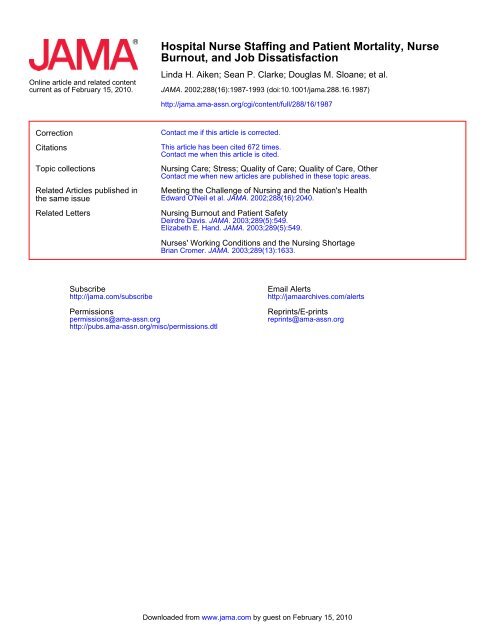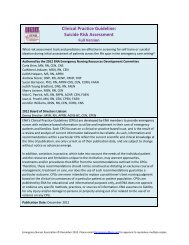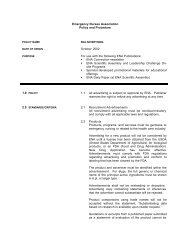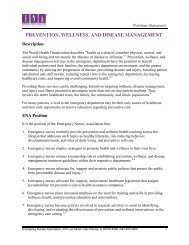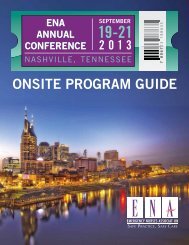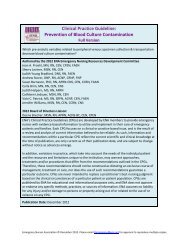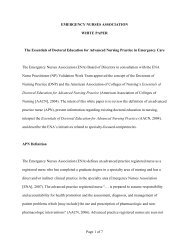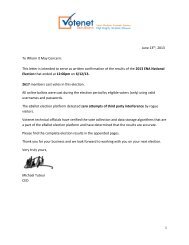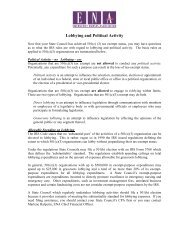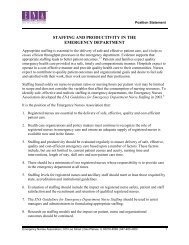Aiken_2002 - Emergency Nurses Association
Aiken_2002 - Emergency Nurses Association
Aiken_2002 - Emergency Nurses Association
You also want an ePaper? Increase the reach of your titles
YUMPU automatically turns print PDFs into web optimized ePapers that Google loves.
Online article and related content<br />
current as of February 15, 2010.<br />
Hospital Nurse Staffing and Patient Mortality, Nurse<br />
Burnout, and Job Dissatisfaction<br />
Linda H. <strong>Aiken</strong>; Sean P. Clarke; Douglas M. Sloane; et al.<br />
JAMA. <strong>2002</strong>;288(16):1987-1993 (doi:10.1001/jama.288.16.1987)<br />
http://jama.ama-assn.org/cgi/content/full/288/16/1987<br />
Correction<br />
Citations<br />
Topic collections<br />
Related Articles published in<br />
the same issue<br />
Related Letters<br />
Contact me if this article is corrected.<br />
This article has been cited 672 times.<br />
Contact me when this article is cited.<br />
Nursing Care; Stress; Quality of Care; Quality of Care, Other<br />
Contact me when new articles are published in these topic areas.<br />
Meeting the Challenge of Nursing and the Nation's Health<br />
Edward O'Neil et al. JAMA. <strong>2002</strong>;288(16):2040.<br />
Nursing Burnout and Patient Safety<br />
Deirdre Davis. JAMA. 2003;289(5):549.<br />
Elizabeth E. Hand. JAMA. 2003;289(5):549.<br />
<strong>Nurses</strong>' Working Conditions and the Nursing Shortage<br />
Brian Cromer. JAMA. 2003;289(13):1633.<br />
Subscribe<br />
http://jama.com/subscribe<br />
Email Alerts<br />
http://jamaarchives.com/alerts<br />
Permissions<br />
permissions@ama-assn.org<br />
http://pubs.ama-assn.org/misc/permissions.dtl<br />
Reprints/E-prints<br />
reprints@ama-assn.org<br />
Downloaded from www.jama.com by guest on February 15, 2010
ORIGINAL CONTRIBUTION<br />
Hospital Nurse Staffing and<br />
Patient Mortality, Nurse Burnout,<br />
and Job Dissatisfaction<br />
Linda H. <strong>Aiken</strong>, PhD, RN<br />
Sean P. Clarke, PhD, RN<br />
Douglas M. Sloane, PhD<br />
Julie Sochalski, PhD, RN<br />
Jeffrey H. Silber, MD, PhD<br />
For editorial comment see p 2040.<br />
Context The worsening hospital nurse shortage and recent California legislation<br />
mandating minimum hospital patient-to-nurse ratios demand an understanding of<br />
how nurse staffing levels affect patient outcomes and nurse retention in hospital<br />
practice.<br />
Objective To determine the association between the patient-to-nurse ratio and patient<br />
mortality, failure-to-rescue (deaths following complications) among surgical patients,<br />
and factors related to nurse retention.<br />
Design, Setting, and Participants Cross-sectional analyses of linked data from<br />
10184 staff nurses surveyed, 232342 general, orthopedic, and vascular surgery<br />
patients discharged from the hospital between April 1, 1998, and November 30,<br />
1999, and administrative data from 168 nonfederal adult general hospitals in Pennsylvania.<br />
Main Outcome Measures Risk-adjusted patient mortality and failure-to-rescue<br />
within 30 days of admission, and nurse-reported job dissatisfaction and job-related<br />
burnout.<br />
Results After adjusting for patient and hospital characteristics (size, teaching status,<br />
and technology), each additional patient per nurse was associated with a 7% (odds<br />
ratio [OR], 1.07; 95% confidence interval [CI], 1.03-1.12) increase in the likelihood<br />
of dying within 30 days of admission and a 7% (OR, 1.07; 95% CI, 1.02-1.11) increase<br />
in the odds of failure-to-rescue. After adjusting for nurse and hospital characteristics,<br />
each additional patient per nurse was associated with a 23% (OR, 1.23; 95%<br />
CI, 1.13-1.34) increase in the odds of burnout and a 15% (OR, 1.15; 95% CI, 1.07-<br />
1.25) increase in the odds of job dissatisfaction.<br />
Conclusions In hospitals with high patient-to-nurse ratios, surgical patients experience<br />
higher risk-adjusted 30-day mortality and failure-to-rescue rates, and nurses<br />
are more likely to experience burnout and job dissatisfaction.<br />
JAMA. <strong>2002</strong>;288:1987-1993<br />
www.jama.com<br />
THE PAST DECADE HAS BEEN A TURbulent<br />
time for US hospitals and<br />
practicing nurses. News media<br />
have trumpeted urgent concerns<br />
about hospital understaffing and<br />
a growing hospital nurse shortage. 1-3<br />
<strong>Nurses</strong> nationwide consistently report<br />
that hospital nurse staffing levels are inadequate<br />
to provide safe and effective<br />
care. 4-6 Physicians agree, citing inadequate<br />
nurse staffing as a major impediment<br />
to the provision of high-quality<br />
hospital care. 7 The shortage of hospital<br />
nurses may be linked to unrealistic nurse<br />
workloads. 8 Forty percent of hospital<br />
nurses have burnout levels that exceed<br />
the norms for health care workers. 4 Job<br />
dissatisfaction among hospital nurses is<br />
4 times greater than the average for all<br />
US workers, and 1 in 5 hospital nurses<br />
report that they intend to leave their current<br />
jobs within a year. 4<br />
In 1999, California passed legislation<br />
mandating patient-to-nurse ratios<br />
for its hospitals, which goes into<br />
effect in July 2003. The California legislation<br />
was motivated by an increasing<br />
hospital nursing shortage and the<br />
perception that lower nurse retention<br />
in hospital practice was related to burdensome<br />
workloads and high levels of<br />
job-related burnout and job dissatisfaction.<br />
Stakeholder groups advocated<br />
widely divergent minimum ratios.<br />
On medical and surgical units,<br />
recommended ratios ranged from 3<br />
to 10 patients for each nurse. 9-11 In<br />
early <strong>2002</strong>, California’s governor announced<br />
that hospitals must have at<br />
least 1 licensed nurse for every 6 medical<br />
and surgical patients by July 2003,<br />
Author Affiliations: Center for Health Outcomes and<br />
Policy Research, School of Nursing (Drs <strong>Aiken</strong>, Clarke,<br />
Sloane, and Sochalski), Leonard Davis Institute of Health<br />
Economics (Drs <strong>Aiken</strong>, Clarke, Sochalski, and Silber), Department<br />
of Sociology (Dr <strong>Aiken</strong>), Population Studies<br />
Center (Drs <strong>Aiken</strong>, Sloane, and Sochalski), and Departments<br />
of Pediatrics and Anesthesia, School of Medicine<br />
(Dr Silber), University of Pennsylvania, Philadelphia;<br />
and Center for Outcomes Research, Children’s<br />
Hospital of Philadelphia, Philadelphia, Pa (Dr Silber).<br />
Corresponding Author and Reprints: Linda H. <strong>Aiken</strong>,<br />
PhD, RN, Center for Health Outcomes and Policy Research,<br />
University of Pennsylvania, 420 Guardian Dr,<br />
Philadelphia, PA 19104-6096 (e-mail: laiken@nursing<br />
.upenn.edu).<br />
©<strong>2002</strong> American Medical <strong>Association</strong>. All rights reserved. (Reprinted) JAMA, October 23/30, <strong>2002</strong>—Vol 288, No. 16 1987<br />
Downloaded from www.jama.com by guest on February 15, 2010
NURSE STAFFING AND HOSPITAL OUTCOMES<br />
a ratio that will move to 1 to 5 when<br />
the mandates are fully implemented. 12<br />
This study reports on findings from a<br />
comprehensive study of 168 hospitals<br />
and clarifies the impact of nurse staffing<br />
levels on patient outcomes and factors<br />
that influence nurse retention. 13 Specifically,<br />
we examined whether riskadjusted<br />
surgical mortality and rates of<br />
failure-to-rescue (deaths in surgical patients<br />
who develop serious complications)<br />
are lower in hospitals where nurses<br />
carry smaller patient loads. In addition,<br />
we ascertained the extent to which more<br />
favorable patient-to-nurse ratios are associated<br />
with lower burnout and higher<br />
job satisfaction among registered nurses.<br />
We also estimated excess surgical deaths<br />
associated with the different nurse staffing<br />
ratios vigorously debated in California.<br />
Finally, we estimated the impact of<br />
nurse staffing levels proposed in California<br />
on nurse burnout and dissatisfaction,<br />
2 precursors of turnover. 13 Our findings<br />
offer insights into how more<br />
generous registered nurse staffing might<br />
affect patient outcomes and inform current<br />
debates in many states regarding the<br />
merits of legislative actions to influence<br />
staffing levels.<br />
METHODS<br />
Patients, Data Sources,<br />
and Variables<br />
Our study combines information about<br />
hospital staffing and organization obtained<br />
from nurse surveys with patient<br />
outcomes derived from hospital discharge<br />
abstracts and hospital characteristics<br />
drawn from administrative databases.<br />
14 The study protocol for linking<br />
anonymized nurse data and handling denominalized<br />
patient data was approved<br />
by the institutional review board<br />
of the University of Pennsylvania.<br />
Hospitals. Data were collected on all<br />
210 adult general hospitals in Pennsylvania.<br />
Information about hospital characteristics<br />
was derived from the 1999<br />
American Hospital <strong>Association</strong> (AHA)<br />
Annual Survey and the 1999 Pennsylvania<br />
Department of Health Hospital<br />
Survey. 15,16 Ultimately, 168 of the 210<br />
acute care hospitals had discharge data<br />
for surgical patients in the targeted Diagnosis<br />
Related Groups (DRGs) during<br />
the study period, as well AHA data,<br />
and survey data from 10 or more staff<br />
nurses. Six of the excluded hospitals<br />
were Veterans Affairs hospitals, which<br />
do not report discharge data to the state.<br />
Twenty-six hospitals were excluded because<br />
their administrative or patient outcomes<br />
data could not be matched to our<br />
surveys because of missing variables, primarily<br />
because they reported their characteristics<br />
or patient data as aggregate<br />
multihospital entities. In 10 additional<br />
small hospitals, the majority of which<br />
had fewer than 50 beds, fewer than 10<br />
nurses responded to the survey.<br />
A nurse staffing measure was calculated<br />
as the mean patient load across all<br />
staff registered nurses who reported<br />
having responsibility for at least 1 but<br />
fewer than 20 patients on the last shift<br />
they worked, regardless of the specialty<br />
or shift (day, evening, night)<br />
worked. This measure of staffing is<br />
superior to those derived from administrative<br />
databases, which generally<br />
include registered nurse positions that<br />
do not involve inpatient acute care at<br />
the bedside. Staffing was measured<br />
across entire hospitals because there is<br />
no evidence that specialty-specific staffing<br />
offers advantages in the study of<br />
patient outcome 17 and to reflect the fact<br />
that patients often receive nursing care<br />
in multiple specialty areas of a hospital.<br />
Direct measurement also avoided<br />
problems with missing data common<br />
to the AHA’s Annual Survey of hospitals,<br />
which imputed staffing data in 1999<br />
for 20% of Pennsylvania hospitals.<br />
Three hospital characteristics were<br />
used as control variables: size, teaching<br />
status, and technology. Hospitals were<br />
grouped into 3 size categories: small<br />
(100 hospital beds), medium (101-<br />
250 hospital beds), and large (251 hospital<br />
beds). Teaching status was measured<br />
by the ratio of resident physicians<br />
and fellows to hospital beds, which has<br />
been suggested as superior to university<br />
affiliations and association memberships<br />
as an indicator of the intensity of<br />
teaching activity. 18 Hospitals with no<br />
postgraduate trainees (nonteaching)<br />
were contrasted with those that had 1:4<br />
or smaller trainee:bed ratios (minor<br />
teaching hospitals) and those with ratios<br />
that were higher than 1:4 (major<br />
teaching hospitals). Finally, hospitals<br />
with facilities for open heart surgery<br />
and/or major transplants were classified<br />
as high-technology hospitals and<br />
contrasted with other hospitals. 19<br />
<strong>Nurses</strong> and Nurse Outcomes. Surveys<br />
were mailed in the spring of 1999<br />
to a 50% random sample of registered<br />
nurses who were on the Pennsylvania<br />
Board of Nursing rolls and resided in the<br />
state. The response rate was 52%, which<br />
compares favorably with rates seen in<br />
other voluntary surveys of health professionals.<br />
20 Roughly one third of the<br />
nurses who responded worked in hospitals<br />
and included the sample of 10184<br />
nurses described here. No special recruiting<br />
methods or inducements were<br />
used. Demographic characteristics of the<br />
respondents matched the profile for<br />
Pennsylvania nurses in the National<br />
Sample Survey of Registered <strong>Nurses</strong>. 21<br />
<strong>Nurses</strong> employed in hospitals were asked<br />
to use a list to identify the hospital in<br />
which they worked, and then were queried<br />
about their demographic characteristics,<br />
work history, workload, job satisfaction,<br />
and feelings of job-related<br />
burnout. Questionnaires were returned<br />
by nurses employed at each of the 210<br />
Pennsylvania hospitals providing adult<br />
acute care. To obtain reliable hospitallevel<br />
estimates of nurse staffing (the ratio<br />
of patients to nurses in each hospital),<br />
attention was restricted to registered<br />
nurses holding staff nurse positions involving<br />
direct patient care and to hospitals<br />
from which at least 10 such nurses<br />
returned questionnaires. In 80% of the<br />
168 hospitals in the final sample, 20 or<br />
more nurses provided responses to our<br />
questionnaire. There were more than 50<br />
nurse respondents from half of the hospitals.<br />
We examined 2 nurse job outcomes<br />
in relation to staffing: job satisfaction<br />
(rated on a 4-point scale from very<br />
dissatisfied to very satisfied) and burnout<br />
(measured with the Emotional Exhaustion<br />
scale of the Maslach Burnout<br />
Inventory, a standardized tool). 22,23<br />
Patients and Patient Outcomes. Discharge<br />
abstracts representing all admis-<br />
1988 JAMA, October 23/30, <strong>2002</strong>—Vol 288, No. 16 (Reprinted) ©<strong>2002</strong> American Medical <strong>Association</strong>. All rights reserved.<br />
Downloaded from www.jama.com by guest on February 15, 2010
NURSE STAFFING AND HOSPITAL OUTCOMES<br />
Box. Surgical Patient Diagnosis Related Groups Included<br />
in the Analyses of Mortality and Failure-to-Rescue<br />
General Surgery<br />
146-155, 157-162, 164-167, 170, 171, 191-201, 257-268, 285-293, 493, and 494<br />
Orthopedic Surgery<br />
209-211, 213, 216-219, 223-234, 471, 491, and 496-503<br />
Vascular Surgery<br />
110-114, 119, and 120<br />
sions to nonfederal hospitals in Pennsylvaniafrom1998to1999wereobtained<br />
from the Pennsylvania Health Care Cost<br />
Containment Council. These discharge<br />
abstracts were merged with Pennsylvania<br />
vital statistics records to identify<br />
patients who died within 30 days of hospital<br />
admission to control for timing of<br />
discharge as a possible source of variation<br />
in hospital outcomes. We examined<br />
outcomes for 232342 patients<br />
between the ages of 20 and 85 years who<br />
underwent general surgical, orthopedic,<br />
or vascular procedures in the 168<br />
hospitals from April 1, 1998, to November<br />
30, 1999. Surgical discharges were<br />
selected for study because of the availability<br />
of well-validated risk adjustment<br />
models. 24-29 The number of patients discharged<br />
from the study hospitals ranged<br />
from 75 to 7746. Only the first hospital<br />
admission for any of the DRGs listed in<br />
the BOX for any patient during the study<br />
period was included in the analyses.<br />
In addition to 30-day mortality, we<br />
examined failure-to-rescue (deaths<br />
within 30 days of admission among<br />
patients who experienced complications).<br />
24-29 Complications were identified<br />
by scanning discharge abstracts for<br />
International Classification of Diseases,<br />
Ninth Revision, Clinical Modification<br />
(ICD-9-CM) codes in the secondary diagnosis<br />
and procedure fields that were<br />
suggestive of 39 different clinical events.<br />
Distinguishing complications from previously<br />
existing comorbidities involved<br />
the use of rules developed by expert<br />
consensus and previous empirical<br />
work, as well as examination of discharge<br />
records for each patient’s hospitalizations<br />
90 days before the surgery of<br />
interest for overlap in secondary diagnosis<br />
codes. 27-29 Examples of complications<br />
included aspiration pneumonia<br />
and hypotension/shock. Patients who<br />
died postoperatively were assumed to<br />
have developed a complication even if<br />
no complication codes were identified<br />
in their discharge abstracts.<br />
Risk adjustment of mortality and failure-to-rescue<br />
for patient characteristics<br />
and comorbidities was accomplished<br />
by using 133 variables, including<br />
age, sex, surgery types, and dummy variables<br />
indicating the presence of chronic<br />
preexisting health conditions reflected<br />
in the ICD-9-CM codes in the discharge<br />
abstracts (eg, diabetes mellitus),<br />
as well as a series of interaction<br />
terms. The final set of control variables<br />
was determined by a selection process<br />
that paralleled an approach used and reported<br />
previously. 27-29 The C statistic<br />
(area under the receiver operating characteristic<br />
curve) for the mortality risk adjustment<br />
model was 0.89. 30<br />
Data Analysis<br />
Descriptive data show how patients and<br />
nurses in our sample were distributed<br />
across the various categories of hospitals<br />
defined by staffing levels and other<br />
characteristics. Logistic regression models<br />
were used to estimate the effects of<br />
staffing on the nurse outcomes (job dissatisfaction<br />
and burnout) and 2 patient<br />
outcomes (mortality and failure-torescue).<br />
We computed the odds of<br />
nurses being moderately or very dissatisfied<br />
with their current positions and<br />
reporting a level of emotional exhaustion<br />
(burnout) above published norms<br />
for medical workers and of patients experiencing<br />
mortality and failure-torescue<br />
under different levels of registered<br />
nurse staffing, before and after<br />
control for individual characteristics and<br />
hospital variables. For nurse outcomes,<br />
we adjusted for sex, years of experience<br />
in nursing, education (baccalaureate<br />
degree or above vs diploma or<br />
associate degree as highest credential in<br />
nursing), and nursing specialty. For<br />
analyses of patient outcomes, we controlled<br />
for the variables in our risk adjustment<br />
model, specifically, demographic<br />
characteristics of patients, nature<br />
of the hospital admission, comorbidities,<br />
and relevant interaction terms. For<br />
analyses of both patient and nurse outcomes,<br />
we adjusted for hospital size,<br />
teaching status, and technology.<br />
All logistic regression models were estimated<br />
by using Huber-White (robust)<br />
procedures to account for the clustering<br />
of patients within hospitals and<br />
adjust the SEs of the parameter estimates<br />
appropriately. 31,32 Model calibration<br />
was assessed with the Hosmer-<br />
Lemeshow statistic. 33 We used direct<br />
standardization to illustrate the magnitude<br />
of the effect of staffing by estimating<br />
the difference in the numbers of<br />
deaths and episodes of failure-torescue<br />
under different staffing scenarios.<br />
Using all patients in the study and<br />
using the final fully-adjusted model, we<br />
estimated the probability of death and<br />
failure-to-rescue for each patient under<br />
various patient-to-nurse ratios (ie,<br />
4, 6, and 8 patients per nurse) with all<br />
other patient characteristics unchanged.<br />
We then calculated the differences<br />
in total deaths under the different<br />
scenarios. 34 Confidence intervals<br />
(CIs) for these direct standardization estimates<br />
were derived with the method<br />
described by Agresti. 35 All analyses were<br />
performed using STATA version 7.0<br />
(STATA Corp, College Station, Tex), and<br />
P
NURSE STAFFING AND HOSPITAL OUTCOMES<br />
Table 1. Study Hospitals, Surgical Patients Studied, and Nurse Respondents in Hospitals*<br />
No. (%)<br />
Characteristic<br />
Hospitals<br />
(N = 168)<br />
Patients<br />
(N = 232 342)<br />
<strong>Nurses</strong><br />
(N = 10 184)<br />
Staffing, patients per nurse<br />
4 20 (11.9) 41 414 (17.8) 1741 (17.1)<br />
5 64 (38.1) 111 752 (48.1) 4818 (47.3)<br />
6 41 (24.4) 48 120 (20.7) 2114 (20.8)<br />
7 29 (17.3) 21 360 (9.2) 1106 (10.9)<br />
8 14 (8.3) 9696 (4.2) 405 (4.0)<br />
Size, No. of beds<br />
100 41 (24.4) 16 123 (6.9) 842 (8.3)<br />
101-250 95 (56.6) 110 510 (47.6) 4927 (48.4)<br />
251 32 (19.1) 105 709 (45.5) 4415 (43.4)<br />
Technology<br />
Not high 121 (72.0) 103 824 (44.7) 4706 (46.2)<br />
High 47 (28.0) 128 518 (55.3) 5478 (53.8)<br />
Teaching status<br />
None 107 (63.7) 98 937 (42.6) 4553 (44.7)<br />
Minor 44 (26.2) 80 127 (34.5) 3435 (33.7)<br />
Major 17 (10.1) 53 278 (22.9) 2196 (21.6)<br />
*Percentages may not add up to 100 because of rounding.<br />
Table 2. Characteristics of <strong>Nurses</strong><br />
(N = 10 184) in the Study Hospitals*<br />
Characteristic No. (%)<br />
Women 9425 (94.1)<br />
BSN degree or higher 3980 (39.6)<br />
Years worked as a nurse, mean (SD) 13.8 (9.8)<br />
Clinical specialty<br />
Medical and surgical 3158 (31.0)<br />
Intensive care 1992 (19.6)<br />
Operating/recovery room 998 (9.8)<br />
Other 4026 (39.6)<br />
High emotional exhaustion 3926 (43.2)<br />
Dissatisfied with current job 4162 (41.5)<br />
*Sample size for individual characteristics varied because<br />
of missing data. BSN indicates bachelor of science<br />
in nursing. High emotional exhaustion refers to levels<br />
of emotional exhaustion above the published “high”<br />
norm for medical workers. 20 Dissatisfied with current job<br />
combines nurses who reported being either very dissatisfied<br />
or a little dissatisfied.<br />
TABLE 1. Fifty percent of the hospitals<br />
had patient-to-nurse ratios that were 5:1<br />
or lower, and those hospitals discharged<br />
65.9% of the patients in the<br />
study and employed 64.4% of the nurses<br />
we surveyed. Hospitals with more than<br />
250 beds accounted for a disproportionate<br />
share of both patients and nurses<br />
(45.5% and 43.4%, respectively). Although<br />
high-technology hospitals accounted<br />
for only 28.0% of the institutions<br />
studied, more than half (55.3%)<br />
of the patients discharged and 53.8%<br />
of nurses surveyed were from hightechnology<br />
hospitals. A majority of<br />
the patients studied and nurses surveyed<br />
were drawn from the 61 hospitals<br />
(36.3%) that reported postgraduate<br />
medical trainees in 1999.<br />
As shown in TABLE 2, 94.1% of the<br />
nurses were women and 39.6% held a<br />
baccalaureate degree or higher. The<br />
mean (SD) work experience in nursing<br />
was 13.8 years (9.8). Thirty-one percent<br />
of the nurses in the sample worked<br />
on medical and surgical general units,<br />
while 19.6% and 9.8% worked in intensive<br />
care and perioperative settings,<br />
respectively. Forty-three percent<br />
of the nurses had high burnout<br />
scores and a similar proportion were<br />
dissatisfied with their current jobs.<br />
Of the 232342 patients studied, 53813<br />
(23.2%) experienced a major complication<br />
not present on admission and 4535<br />
(2.0%) died within 30 days of admission.<br />
The death rate among patients with<br />
complications was 8.4%. The surgical<br />
case types and clinical characteristics of<br />
the patient cohort are shown in TABLE 3.<br />
Slightly more than half of patients<br />
(51.2%) were classified in an orthopedic<br />
surgery DRG, with the next largest<br />
group of patients (36.4%) undergoing digestive<br />
tract and hepatobiliary surgeries.<br />
Chronic medical conditions, with the<br />
exception of hypertension, were relatively<br />
uncommon among these patients.<br />
Patients who experienced complications<br />
and were included in our<br />
analyses of failure-to-rescue were similar<br />
to the broader group of patients in our<br />
mortality analyses with respect to their<br />
comorbidities, but orthopedic surgery<br />
patients were less prominently represented<br />
among patients with complications<br />
than in the overall sample.<br />
Staffing and Job Satisfaction<br />
and Burnout<br />
Higher emotional exhaustion and greater<br />
job dissatisfaction in nurses were strongly<br />
and significantly associated with patientto-nurse<br />
ratios. TABLE 4 shows odds<br />
ratios (ORs) indicating how much more<br />
likely nurses in hospitals with higher<br />
patient-to-nurse ratios were to exhibit<br />
burnout scores above published norms<br />
and to be dissatisfied with their jobs. Controlling<br />
for nurse and hospital characteristics<br />
resulted in a slight increase in<br />
these ratios, which in both cases indicated<br />
a pronounced effect of staffing. The<br />
final adjusted ORs indicated that an<br />
increase of 1 patient per nurse to a hospital’sstaffinglevelincreasedburnoutand<br />
job dissatisfaction by factors of 1.23 (95%<br />
CI, 1.13-1.34) and 1.15 (95% CI, 1.07-<br />
1.25), respectively, or by 23% and 15%.<br />
This implies that nurses in hospitals with<br />
8:1 patient-to-nurse ratios would be 2.29<br />
times as likely as nurses with 4:1 patientto-nurse<br />
ratios to show high emotional<br />
exhaustion (ie, 1.23 to the 4th power for<br />
4additionalpatientspernurse=2.29)and<br />
1.75 times as likely to be dissatisfied with<br />
their jobs (ie, 1.15 to the 4th power for<br />
4 additional patients per nurse=1.75).<br />
Our data further indicate that, although<br />
43% of nurses who report high burnout<br />
and are dissatisfied with their jobs intend<br />
to leave their current job within the next<br />
12 months, only 11% of the nurses who<br />
are not burned out and who remain satisfied<br />
with their jobs intend to leave.<br />
Staffing and Patient Mortality<br />
and Failure-to-Rescue<br />
Among the surgical patients studied,<br />
there was a pronounced effect of nurse<br />
staffing on both mortality and mortality<br />
following complications. Table 4 also<br />
shows the relationship between nurse<br />
staffing and patient mortality and failure-<br />
1990 JAMA, October 23/30, <strong>2002</strong>—Vol 288, No. 16 (Reprinted) ©<strong>2002</strong> American Medical <strong>Association</strong>. All rights reserved.<br />
Downloaded from www.jama.com by guest on February 15, 2010
NURSE STAFFING AND HOSPITAL OUTCOMES<br />
to-rescue (mortality following complications)<br />
when other factors were ignored,<br />
after patient characteristics were<br />
controlled, and after patient characteristics<br />
and other hospital characteristics<br />
(size, teaching status, and technology)<br />
were controlled. Although the ORs reflecting<br />
the nurse staffing effect were<br />
somewhat diminished by controlling for<br />
patient and hospital characteristics, they<br />
remained sizable and significant for both<br />
mortality and failure-to-rescue (1.07;<br />
95% CI, 1.03-1.12 and 1.07; 95% CI,<br />
1.02-1.11, respectively). An OR of 1.07<br />
implies that the odds of patient mortality<br />
increased by 7% for every additional<br />
patient in the average nurse’s workload<br />
in the hospital and that the difference<br />
from 4 to 6 and from 4 to 8 patients per<br />
nurse would be accompanied by 14% and<br />
31% increases in mortality, respectively<br />
(ie, 1.07 to the 2nd power=1.14 and 1.07<br />
to the 4th power=1.31).<br />
These effects imply that, all else being<br />
equal, substantial decreases in mortality<br />
rates could result from increasing registered<br />
nurse staffing, especially for patients<br />
who develop complications. Direct<br />
standardization techniques were used to<br />
predict excess deaths in all patients and<br />
in patients with complications that would<br />
be expected if the patient-to-nurse ratio<br />
for all patients in the study were at various<br />
levels that figure prominently in the<br />
California staffing mandate debates. If the<br />
staffing ratio in all hospitals was 6 patients<br />
per nurse rather than 4 patients per<br />
nurse, we would expect 2.3 (95% CI, 1.1-<br />
3.5) additional deaths per 1000 patients<br />
and 8.7 (95% CI, 3.9-13.5) additional<br />
deaths per 1000 patients with<br />
complications. If the staffing ratio in all<br />
hospitals was 8 patients per nurse rather<br />
than 6 patients per nurse, we would expect<br />
2.6 (95% CI, 1.2-4.0) additional<br />
deaths per 1000 patients and 9.5 (95%<br />
CI, 3.8-15.2) additional deaths per 1000<br />
Table 3. Characteristics of the Surgical Patients Included in Analyses of Mortality and<br />
Failure-to-Rescue*<br />
No. (%)<br />
Patients With<br />
All Patients Complications<br />
Characteristic<br />
(N = 232 342) (n = 53 813)<br />
Men 101 624 (43.7) 25 619 (47.6)<br />
Age, mean (SD) 59.3 (16.9) 64.2 (15.7)<br />
<strong>Emergency</strong> admissions 63 355 (27.3) 21 541 (40.0)<br />
Deaths within 30 days of admission 4535 (2.0) 4535 (8.4)<br />
Major Diagnostic Categories (MDCs)<br />
General surgery<br />
Diseases and disorders of the<br />
54 919 (23.6) 19 002 (35.3)<br />
digestive system (MDC 6)<br />
Diseases and disorders of the hepatobiliary<br />
29 660 (12.8) 6804 (12.6)<br />
system (MDC 7)<br />
Diseases and disorders of the skin,<br />
12 771 (5.5) 3010 (5.6)<br />
subcutaneous tissue, and breast (MDC 9)<br />
Endocrine, nutritional, metabolic diseases,<br />
4853 (2.1) 1535 (2.9)<br />
and disorders (MDC 10)<br />
Orthopedic surgery<br />
Diseases and disorders of the musculoskeletal 118 945 (51.2) 17 403 (32.3)<br />
system (MDC 8)<br />
Vascular surgery<br />
Diseases and disorders of the circulatory<br />
11 194 (4.8) 6059 (11.3)<br />
system (MDC 5)<br />
Medical history (comorbidities)<br />
Congestive heart failure 11 795 (5.1) 5735 (10.7)<br />
Arrhythmia 3965 (1.7) 1765 (3.3)<br />
Aortic stenosis 2248 (1.0) 848 (1.6)<br />
Hypertension 79 827 (34.4) 20 648 (38.4)<br />
Cancer 28 558 (12.3) 9074 (16.9)<br />
Chronic obstructive pulmonary disease 19 819 (8.5) 7612 (14.2)<br />
Diabetes mellitus (insulin and noninsulin dependent) 31 385 (13.5) 9597 (17.8)<br />
Insulin-dependent diabetes mellitus 3607 (1.6) 1755 (3.3)<br />
*Patients who died postoperatively were assumed to have developed a complication even if no complication codes<br />
were identified in their discharge abstracts.<br />
Table 4. Patient-to-Nurse Ratios With High Emotional Exhaustion and Job Dissatisfaction Among Staff <strong>Nurses</strong> and With Patient Mortality and<br />
Failure-to-Rescue*<br />
Odds Ratio (95% Confidence Interval)<br />
Unadjusted<br />
P<br />
Value<br />
Adjusted for<br />
Nurse or Patient<br />
Characteristics<br />
P<br />
Value<br />
Adjusted for<br />
Nurse or Patient and<br />
Hospital Characteristics<br />
Nurse outcomes<br />
High emotional exhaustion 1.17 (1.10-1.26) .001 1.17 (1.10-1.26) .001 1.23 (1.13-1.34) .001<br />
Job dissatisfaction 1.11 (1.03-1.19) .004 1.12 (1.04-1.19) .001 1.15 (1.07-1.25) .001<br />
Patient outcomes<br />
Mortality 1.14 (1.08-1.19) .001 1.09 (1.04-1.13) .001 1.07 (1.03-1.12) .001<br />
Failure-to-rescue 1.11 (1.06-1.17) .004 1.09 (1.04-1.13) .001 1.07 (1.02-1.11) .001<br />
*Odds ratios, indicating the risk associated with an increase of 1 patient per nurse, and confidence intervals were derived from robust logistic regression models that accounted for<br />
the clustering (and lack of independence) of observations within hospitals. Nurse characteristics were adjusted for sex, experience (years worked as a nurse), type of degree, and<br />
type of unit. Patient characteristics were adjusted for the patient’s Diagnosis Related Groups, comorbidities, and significant interactions between them. Hospital characteristics<br />
were adjusted for high technology, teaching status, and size (number of beds).<br />
P<br />
Value<br />
©<strong>2002</strong> American Medical <strong>Association</strong>. All rights reserved. (Reprinted) JAMA, October 23/30, <strong>2002</strong>—Vol 288, No. 16 1991<br />
Downloaded from www.jama.com by guest on February 15, 2010
NURSE STAFFING AND HOSPITAL OUTCOMES<br />
patients with complications. Staffing hospitals<br />
uniformly at 8 vs 4 patients per<br />
nurse would be expected to entail 5.0<br />
(95% CI, 2.4-7.6) excess deaths per 1000<br />
patients and 18.2 (95% CI, 7.7-28.7) excess<br />
deaths per 1000 complicated patients.<br />
We were unable to estimate excess<br />
deaths or failures associated with a<br />
ratio of 10 patients per nurse (one of the<br />
levels proposed in California) because<br />
there were so few hospitals in our sample<br />
staffed at that level.<br />
COMMENT<br />
Registered nurses constitute an aroundthe-clock<br />
surveillance system in hospitals<br />
for early detection and prompt intervention<br />
when patients’ conditions<br />
deteriorate. The effectiveness of nurse<br />
surveillance is influenced by the number<br />
of registered nurses available to assess<br />
patients on an ongoing basis. Thus, it is<br />
not surprising that we found nurse staffing<br />
ratios to be important in explaining<br />
variation in hospital mortality. Numerous<br />
studies have reported an association<br />
between more registered nurses and<br />
lower hospital mortality, but often as a<br />
by-product of analyses focusing directly<br />
on some other aspect of hospital<br />
resources such as ownership, teaching<br />
status, or anesthesiologist direction.<br />
19,27,36-42 Therefore, a simple search<br />
for literature dealing with the relationship<br />
between nurse staffing and patient<br />
outcomes yields only a fraction of the<br />
studies that have relevant findings. The<br />
relative inaccessibility of this evidence<br />
base might account for the influential<br />
Audit Commission in England concluding<br />
recently that there is no evidence that<br />
more favorable patient-to-nurse ratios<br />
result in better patient outcomes. 43<br />
Our results suggest that the California<br />
hospital nurse staffing legislation<br />
represents a credible approach to reducing<br />
mortality and increasing nurse<br />
retention in hospital practice, if it can<br />
be successfully implemented. Moreover,<br />
our findings suggest that California<br />
officials were wise to reject ratios<br />
favored by hospital stakeholder groups<br />
of 10 patients to each nurse on medical<br />
and surgical general units in favor<br />
of more generous staffing requirements<br />
of 5 to 6 patients per nurse. Our<br />
results do not directly indicate how<br />
many nurses are needed to care for patients<br />
or whether there is some maximum<br />
ratio of patients per nurse above<br />
which hospitals should not venture.<br />
Our major point is that there are detectable<br />
differences in risk-adjusted<br />
mortality and failure-to-rescue rates<br />
across hospitals with different registered<br />
nurse staffing ratios.<br />
In our sample of 168 Pennsylvania<br />
hospitals in which the mean patient-tonurse<br />
ratio ranged from 4:1 to 8:1, 4535<br />
of the 232342 surgical patients with the<br />
clinical characteristics we selected died<br />
within 30 days of being admitted. Our<br />
results imply that had the patient-tonurse<br />
ratio across all Pennsylvania hospitals<br />
been 4:1, possibly 4000 of these patients<br />
may have died, and had it been 8:1,<br />
more than 5000 of them may have died.<br />
While this difference of 1000 deaths in<br />
Pennsylvania hospitals across the 2 staffing<br />
scenarios is approximate, it represents<br />
a conservative estimate of preventable<br />
deaths attributable to nurse staffing<br />
in the state. Our sample of patients represents<br />
only about half of all surgical<br />
cases in these hospitals, and other patients<br />
admitted to these hospitals are at<br />
risk of dying and similarly subject to the<br />
effects of staffing. Moreover, in California,<br />
which has nearly twice as many acute<br />
care hospitals and discharges and an<br />
overall inpatient mortality rate higher<br />
than in our sample in Pennsylvania (2.3%<br />
vs 2.0%), it would be reasonable to expect<br />
that the difference of 4 fewer patients<br />
per nurse might result in 2000 or<br />
more preventable deaths throughout a<br />
similar period.<br />
Our results further indicate that nurses<br />
in hospitals with the highest patient-tonurse<br />
ratios are more than twice as likely<br />
to experience job-related burnout and<br />
almost twice as likely to be dissatisfied<br />
with their jobs compared with nurses in<br />
the hospitals with the lowest ratios. This<br />
effect of staffing on job satisfaction and<br />
burnout suggests that improvements in<br />
nurse staffing in California hospitals<br />
resulting from the new legislation could<br />
be accompanied by declines in nurse<br />
turnover. We found that burnout and<br />
dissatisfaction predict nurses’ intentions<br />
to leave their current jobs within<br />
a year. Although we do not know how<br />
many of the nurses who indicated intentions<br />
to leave their jobs actually did so,<br />
it seems reasonable to assume that the<br />
4-fold difference in intentions across<br />
these 2 groups translated to at least a<br />
similar difference in nurse resignations.<br />
If recently published estimates of<br />
the costs of replacing a hospital medical<br />
and surgical general unit and a specialty<br />
nurse of $42000 and $64000,<br />
respectively, are correct, improving staffing<br />
may not only save patient lives and<br />
decrease nurse turnover but also reduce<br />
hospital costs. 44<br />
Additional analyses indicate that our<br />
conclusions about the effects of staffing<br />
and the size of these effects are similar<br />
under a variety of specifications. We<br />
allowed the effect of nurse staffing to<br />
be nonlinear (using a quadratic term)<br />
and vary in size across staffing levels (using<br />
dummy variables and interaction<br />
terms) and found no evidence in this<br />
sample of hospitals that additional registered<br />
nurse staffing has different effects<br />
at differing staffing levels. Limiting our<br />
analyses to general and orthopedic surgery<br />
patients and eliminating vascular<br />
surgery patients (who have higher mortality<br />
and complication rates) did not<br />
affect our conclusions and effect-size<br />
estimates. Also, our findings were not<br />
changed by restricting attention to inpatient<br />
deaths vs deaths within 30 days<br />
of admission. Results were unaffected<br />
by restricting analyses to patients who<br />
were discharged after our staffing measures<br />
were obtained, rather than to the<br />
patients who were discharged from 9<br />
months before to 9 months following<br />
the nurse surveys that produced our<br />
staffing measures. They were also<br />
unchanged by restricting the sample of<br />
nurses from which we derived our staffing<br />
measures to medical and surgical<br />
nurses, as opposed to all staff nurses.<br />
Finally, they were neither altered by<br />
adjusting for patient-to-licensed practical<br />
nurse ratios and patient-tounlicensed<br />
assistive personnel ratios<br />
(neither of which were related to patient<br />
outcomes) nor affected by excluding the<br />
1992 JAMA, October 23/30, <strong>2002</strong>—Vol 288, No. 16 (Reprinted) ©<strong>2002</strong> American Medical <strong>Association</strong>. All rights reserved.<br />
Downloaded from www.jama.com by guest on February 15, 2010
NURSE STAFFING AND HOSPITAL OUTCOMES<br />
hospitals in our sample with smaller<br />
numbers of patients or nurses.<br />
One limitation of this study is the potential<br />
for response bias, given a 52% response<br />
rate. We find no evidence that the<br />
nurses in our sample were disproportionately<br />
dissatisfied with their work relative<br />
to Pennsylvania staff nurses from the<br />
National Sample Survey of Registered<br />
<strong>Nurses</strong> (a national probability-based<br />
sample survey performed in 2000). 21 Furthermore,<br />
with respect to demographic<br />
characteristics (sex, age, and education)<br />
included in both surveys, our<br />
sample of nurses also closely resembles<br />
those participating in the National<br />
Sample Survey of Registered <strong>Nurses</strong>. We<br />
are confident that these results are not<br />
specific to this particular sample of<br />
nurses. Ultimately, longitudinal data sets<br />
will be needed to exclude the possibility<br />
that low hospital nurse staffing is the<br />
consequence, rather than the cause, of<br />
poor patient and nurse outcomes.<br />
Our findings have important implications<br />
for 2 pressing issues: patient<br />
safety and the hospital nurse shortage.<br />
Our results document sizable and significant<br />
effects of registered nurse staffing<br />
on preventable deaths. The association<br />
of nurse staffing levels with the<br />
rescue of patients with life-threatening<br />
conditions suggests that nurses contribute<br />
importantly to surveillance, early detection,<br />
and timely interventions that<br />
save lives. The benefits of improved registered<br />
nurse staffing also extend to the<br />
larger numbers of hospitalized patients<br />
who are not at high risk for mortality but<br />
nevertheless are vulnerable to a wide<br />
range of unfavorable outcomes. Improving<br />
nurse staffing levels may reduce<br />
alarming turnover rates in hospitals by<br />
reducing burnout and job dissatisfaction,<br />
major precursors of job resignation.<br />
When taken together, the impacts<br />
of staffing on patient and nurse<br />
outcomes suggest that by investing in<br />
registered nurse staffing, hospitals may<br />
avert both preventable mortality and low<br />
nurse retention in hospital practice.<br />
Author Contributions: Study concept and design:<br />
<strong>Aiken</strong>, Clarke, Sloane, Sochalski, Silber.<br />
Acquisition of data: <strong>Aiken</strong>, Clarke, Sochalski, Silber.<br />
Analysis and interpretation of data: <strong>Aiken</strong>, Clarke,<br />
Sloane, Silber.<br />
Drafting of the manuscript: <strong>Aiken</strong>, Clarke, Sloane,<br />
Silber.<br />
Critical revision of the manuscript for important intellectual<br />
content: <strong>Aiken</strong>, Clarke, Sloane, Sochalski, Silber.<br />
Statistical expertise: Clarke, Sloane, Silber.<br />
Obtained funding: <strong>Aiken</strong>, Sloane, Sochalski.<br />
Administrative, technical, or material support: <strong>Aiken</strong>,<br />
Clarke, Sochalski, Silber.<br />
Study supervision: <strong>Aiken</strong>, Clarke, Silber.<br />
Funding/Support: This study was supported by grant<br />
R01 NR04513 from the National Institute of Nursing<br />
Research, National Institutes of Health.<br />
Acknowledgment: We thank Paul Allison, PhD, from<br />
the University of Pennsylvania for statistical consultation,<br />
and Xuemei Zhang, MS, Wei Chen, MS, and<br />
Orit Even-Shoshan, MS, from the Center for Outcomes<br />
Research at the Children’s Hospital of Philadelphia<br />
for their assistance.<br />
REFERENCES<br />
1. Stolberg SG. Patient deaths tied to lack of nurses.<br />
New York Times. August 8, <strong>2002</strong>:A18.<br />
2. Parker-Pope T. How to lessen impact of nursing<br />
shortage on your hospital stay. Wall Street Journal.<br />
March 2, 2001:B1.<br />
3. Trafford A. Second opinion: less care for patients.<br />
Washington Post. August 20, <strong>2002</strong>:HE01.<br />
4. <strong>Aiken</strong> LH, Clarke SP, Sloane DM, et al. <strong>Nurses</strong>’ reports<br />
on hospital care in five countries. Health Aff<br />
(Millwood). 2001;20:43-53.<br />
5. Henry J. Kaiser Family Foundation. Survey of physicians<br />
and nurses. Available at: http://www.kff.org<br />
/content/1999/1503. Accessed March 22, <strong>2002</strong>.<br />
6. Shindul-Rothschild J, Berry D, Long-Middleton E.<br />
Where have all the nurses gone? final results of our<br />
Patient Care Survey. Am J Nurs. 1996;96:25-39.<br />
7. Commonwealth Fund. Doctors in five countries see<br />
decline in health care quality. Commonwealth Fund<br />
Quarterly. 2000;6:1-4.<br />
8. Joint Commission on Accreditation of Healthcare<br />
Organizations. Health care at the crossroads: strategies<br />
for addressing the evolving nursing crisis, <strong>2002</strong>.<br />
Available at: http://www.jcaho.org/news+room<br />
/news+release+archives/health+care+at+the<br />
+crossroads.pdf. Accessed September 17, <strong>2002</strong>.<br />
9. Spetz J. What should we expect from California’s<br />
minimum nurse staffing legislation. J Nurs Adm. 2001;<br />
31:132-140.<br />
10. Seago JA. The California experiment: alternatives<br />
for minimum nurse-to-patient ratios. J Nurs Adm.<br />
<strong>2002</strong>;32:48-58.<br />
11. Friedman L. Nurse ratios are still too high. San Francisco<br />
Chronicle. January 30, <strong>2002</strong>:A19.<br />
12. Governor Gray Davis announces proposed nurseto-patient<br />
ratios [press release]. Sacramento, Calif: Office<br />
of the Governor; January 22, <strong>2002</strong>.<br />
13. Lake ET. Advances in understanding and predicting<br />
nurse turnover. Res Sociol Health Care. 1998;15:<br />
147-171.<br />
14. <strong>Aiken</strong> LH, Clarke SP, Sloane DM. Hospital staffing,<br />
organizational support, and quality of care: cross-national<br />
findings. Int J Qual Health Care. <strong>2002</strong>;14:5-13.<br />
15. AHA Annual Survey Database. 1999 ed. Chicago,<br />
Ill: American Hospital <strong>Association</strong>; 1999.<br />
16. Commonwealth of Pennsylvania. Hospital Questionnaire:<br />
Reporting Period July 1, 1998-June 30,<br />
1999. Harrisburg, Pa: Department of Health, Division<br />
of Statistics.<br />
17. Needleman J, Buerhaus PI, Mattke S, Stewart M,<br />
Zelevinsky K. Nurse staffing and patient outcomes in<br />
hospitals. Available at: http://bhpr.hrsa.gov/nursing<br />
/staffstudy.htm. Accessed August 6, <strong>2002</strong>.<br />
18. Ayanian JZ, Weissman JS, Chasan-Taber S, Epstein<br />
AM. Quality of care for two common illnesses<br />
in teaching and nonteaching hospitals. Health Aff<br />
(Millwood). 1998;17:194-205.<br />
19. Hartz AJ, Krakauer H, Kuhn EM, et al. Hospital<br />
characteristics and mortality rates. N Engl J Med. 1989;<br />
321:1720-1725.<br />
20. Asch DA, Jedrziewski MK, Christakis NA. Response<br />
rates to mail surveys published in medical journals.<br />
J Clin Epidemiol. 1997;50:1129-1136.<br />
21. The Registered Nurse Population. Rockville, Md:<br />
US Dept of Health and Human Services; 1996.<br />
22. Maslach C, Jackson SE. Burnout in health professions:<br />
a social psychological analysis. In: Sanders GS, Suls<br />
J, eds. Social Psychology of Health and Illness. Hillsdale,<br />
NJ: Lawrence Erlbaum Associates; 1982:227-251.<br />
23. Maslach C, Jackson SE. Maslach Burnout Inventory<br />
Manual. 2nd ed. Palo Alto, Calif: Consulting Psychologists<br />
Press; 1986.<br />
24. Silber JH, Williams SV, Krakauer H, Schwartz JS.<br />
Hospital and patient characteristics associated with<br />
death after surgery: a study of adverse occurrence and<br />
failure to rescue. Med Care. 1992;30:615-629.<br />
25. Silber JH, Rosenbaum PR, Ross RN. Comparing<br />
the contributions of groups of predictors: which outcomes<br />
vary with hospital rather than patient characteristics?<br />
J Am Stat Assoc. 1995;90:7-18.<br />
26. Silber JH, Rosenbaum PR, Schwartz JS, Ross RN,<br />
Williams SV. Evaluation of the complication rate as a<br />
measure of quality of care in coronary artery bypass<br />
graft surgery. JAMA. 1995;274:317-323.<br />
27. Silber JH, Kennedy SK, Even-Shoshan O, et al. Anesthesiologist<br />
direction and patient outcomes. Anesthesiology.<br />
2000;93:152-163.<br />
28. Silber JH, Rosenbaum PR, Trudeau ME, et al. Multivariate<br />
matching and bias reduction in the surgical<br />
outcomes study. Med Care. 2001;39:1048-1064.<br />
29. Silber JH, Kennedy SK, Even-Shoshan O, et al. Anesthesiologist<br />
board certification and patient outcomes.<br />
Anesthesiology. <strong>2002</strong>;96:1044-1052.<br />
30. Hanley JA, McNeil BJ. The meaning and use of<br />
the area under a receiver operating characteristic (ROC)<br />
curve. Radiology. 1982;143:29-36.<br />
31. Huber PJ. The Behavior of Maximum Likelihood<br />
Estimates Under Non-standard Conditions: Proceedings<br />
of the Fifth Berkeley Symposium on Mathematical<br />
Statistics and Probability. Berkeley: University<br />
of California Press; 1967:221-233.<br />
32. White H. Maximum likelihood estimation of misspecified<br />
models. Econometrica. 1982;50:1-25.<br />
33. Hosmer DW, Lemeshow S. Applied Logistic Regression.<br />
New York, NY: John Wiley & Sons Inc; 1989.<br />
34. Bishop YM, Fienberg SE, Holland PW. Discrete<br />
Multivariate Analysis: Theory and Practice. Cambridge,<br />
Mass: MIT Press; 1975.<br />
35. Agresti A. Categorical Data Analysis. New York,<br />
NY: John Wiley & Sons Inc; 1990.<br />
36. Shortell SM, Hughes EFX. The effects of regulation,<br />
competition, and ownership on mortality rates<br />
among hospital inpatients. N Engl J Med. 1988;318:<br />
1100-1107.<br />
37. Institute of Medicine. Nursing Staff in Hospitals<br />
and Nursing Homes: Is It Adequate? Washington, DC:<br />
National Academy Press; 1996.<br />
38. <strong>Aiken</strong> LH, Sloane DM, Lake ET, Sochalski J, Weber<br />
AL. Organization and outcomes of inpatient AIDS<br />
care. Med Care. 1999;37:760-772.<br />
39. Mitchell PH, Shortell SM. Adverse outcomes and<br />
variations in organization of care delivery. Med Care.<br />
1997;35(suppl 11):NS19-NS32.<br />
40. Moses LE, Mosteller F. Institutional differences in<br />
postoperative death rates. JAMA. 1968;203:492-494.<br />
41. Pronovost PJ, Jenckes MW, Dorman T, et al. Organizational<br />
characteristics of intensive care units related<br />
to outcomes of abdominal aortic surgery. JAMA.<br />
1999;281:1310-1317.<br />
42. Needleman J, Buerhaus P, Mattke S, Stewart M,<br />
Zelevinsky K. Nurse-staffing levels and the quality of<br />
care in hospitals. N Engl J Med. <strong>2002</strong>;346:1715-<br />
1722.<br />
43. Audit Commission. Acute Hospital Portfolio: Review<br />
of National Findings: Ward Staffing. London, England:<br />
The Audit Commission; 2001:3.<br />
44. Nursing Executive Committee. Reversing the Flight<br />
of Talent: Nursing Retention in an Era of Gathering<br />
Shortage. Washington, DC: Advisory Board Co; 2000.<br />
©<strong>2002</strong> American Medical <strong>Association</strong>. All rights reserved. (Reprinted) JAMA, October 23/30, <strong>2002</strong>—Vol 288, No. 16 1993<br />
Downloaded from www.jama.com by guest on February 15, 2010


